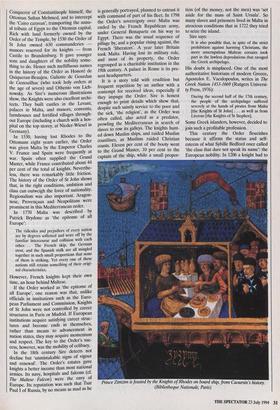The class that dares not speak its name
Philip Mansel
THE KNIGHTS OF MALTA
by H. J. A. Sire
Yale, £40, pp. 305 From the 16th to the 18th century one place where Europe was visible and audible was Malta. It was more international than Rome, Istanbul or Vienna, since the Order of St John, the island's sovereign, recruited its personnel — Catholic knights — more widely than the Papacy or the Ottoman or Habsburg governments. One fascination of J. H. A. Sire's vigorous, well-documented book is that it describes an institution which was both effective and European.
The Order began from a hospice for poor pilgrims founded around 1080, out- side the walls of Jerusalem, by Brother Gerard and a merchant from Amalfi called Mauro di Pantaleone. It rapidly expanded after the crusader conquest of Jerusalem in 1099. Soon the Order ran a hospital in Jerusalem with more than 1000 patients, each one supplied with a dressing-gown and slippers. Founded to serve 'our lords the poor', the Knights of St John also pro- tected the faith. They acquired a string of fortresses, with romantic names and silhou- ettes: Belvoir, Margat, Crac des Chevaliers. In the late 13th century members of the Order resisted the Muslim advance as best they could. As the Muslims breached the walls of Antioch in 1268, the nuns of St John, in Sire's words, lacerated their faces with knives so that their disfigurement should preserve their chastity from the invaders' lust.
In 1310 the Order acquired the island of Rhodes. Henceforward, the Order was a sovereign power, able to defeat the Conqueror of Constantinople himself, the Ottoman Sultan Mehmed, and to intercept the 'Cairo caravan', transporting the annu- al tribute of Egypt to the Ottoman capital. Rich with land formerly owned by the Order of the Temple, by 1530 the Order of St John owned 630 commanderies — manors reserved for its knights — from Castile to Brandenburg. It gave younger sons and daughters of the nobility some- thing to do. Hence such mellifluous names
in the history of the Order as Honore de Quiqueran-Beaujeu, Galiotte de Gourdan de Genouilhac (who took holy orders at the age of seven) and Othenio von Lich- nowsky. As Sire's numerous illustrations show, the Knights were also excellent archi- tects. They built castles in the Levant, palaces in Malta, and manors, convents, farmhouses and fortified villages through- out Europe (including a church with a hos- pital on the top storey, at Nieder-Wiesel in Germany).
In 1530, having lost Rhodes to the Ottomans eight years earlier, the Order was given Malta by the Emperor Charles V. France and Spain were frequently at war. Spain often supplied the Grand Master, while France contributed about 44 per cent of the total of knights. Neverthe- less, there was remarkably little friction. The history of the Order of St John shows that, in the right conditions, ambition and class can outweigh the force of nationality. Regionalism was also important. Aragon- nese, Provencaux and Neapolitans were prominent in this Mediterranean order.
In 1770 Malta was described by Patrick Brydone as 'the epitome of all Europe': The ridicules and prejudices of every nation are by degrees softened and wore off by the familiar intercourse and collision with each other... The French skip, the German strut, and the Spanish stalk are all mingled together in such small proportions that none of them is striking. Yet every one of these nations still retains something of their origi- nal characteristics.
However, French knights kept their own time, an hour behind Maltese.
If the Order worked as 'the epitome of all Europe', one reason was that, unlike officials in institutions such as the Euro- pean Parliament and Commission, Knights of St John were not controlled by career structures in Paris or Madrid. If European institutions acquire satisfying career struc- tures and become ends in themselves, rather than means to advancement in nation states, they may acquire momentum and respect. The key to the Order's suc- cess, however, was the mobility of celibacy.
In the 18th century Sire detects not decline but 'unmistakable signs of vigour and renewal'. The Order's estates gave knights a better income than most national armies. Its navy, hospitals and falcons (cf. The Maltese Falcon) were the envy of Europe. Its reputation was such that Tsar Paul I of Russia, by no means as mad as he is generally portrayed, planned to entrust it with command of part of his fleet. In 1798 the Order's sovereignty over Malta was ended by the French Republican army, under General Bonaparte on his way to Egypt. There was the usual sequence of pillage by, and a popular rising against, the French 'liberators'. A year later Britain took Malta. Having lost its military role, and most of its property, the Order regrouped as a charitable institution in the 19th century. A palace in Rome is its pre- sent headquarters.
It is a story told with erudition but frequent repetition by an author with a contempt for received ideas, especially if they impugn the Order. Sire is honest enough to print details which show that, despite such saintly service to the poor and the sick, 'the religion', as the Order was often called, also acted as a predator, prowling the Mediterranean in search of slaves to row its galleys. The knights hunt- ed down Muslim ships, and raided Muslim coastlines, as Muslims raided Christian coasts. Eleven per cent of the booty went to the Grand Master, 10 per cent to the captain of the ship, while a small propor-
tion (of the money, not the men) was 'set aside for the nuns of Saint Ursula'. So many slaves and prisoners lived in Malta in atrocious conditions that in 1722 they tried to seize the island.
Sire says: It is also possible that, in spite of the strict prohibition against harming Christians, the more unscrupulous Maltese corsairs took part in the lawless depredations that ravaged the Greek archipelago.
His doubt is misplaced. One of the most authoritative historians of modern Greece, Apostolos E. Vacalopoulos, writes in The Greek Nation 1453-1669 (Rutgers Universi- ty Press, 1976):
During the second half of the 17th century, the people of the archipelago suffered severely at the hands of pirates from Malta [the Knights of St John] ... as well as from Livorno [the Knights of St Stephen].
Some Greek islanders, however, decided to join such a profitable profession.
This century the Order flourishes because it affirms the status and self- esteem of what Sybille Bedford once called 'the class that dare not speak its name': the European nobility. In 1206 a knight had to Prince zunurn is feasted by the Argots of Anodes on board ship, from Caoursin's history. (Bibliotheque Nationale, Paris) be legitimately born of a knightly family. Later the requirement was raised so high that the French, who demanded only eight quarterings, were considered slack. Such criteria still define what Sire delightedly calls 'the only genuine aristocratic institu- tion that retains an effective role in the modern world'. It has more than 10,000 knights in 31 national associations: Knights of Justice, who take vows of poverty chasti- ty and obedience; Knights of Obedience; Knights and Dames of Honour and Devo- tion or of Grace and Devotion; Knights and Dames of Magistral Grace — the only ones who do not need to prove noble birth. For the first time in its history the Grand Master is an Englishman, His Most Emi- nent Highness Fra'Andrew Bertie, who lives in Rome surrounded by the panoply of a court. In 1949 the Order preferred to pay a debt of nine million dollars rather than make Eva Peron, who lacked the required quarterings, a Dame of Honour and Devotion: its finances remain a mys- tery which this book does not unravel. To members of the Order, its nobility qualification is the essence of its inter- national character and appeal. Outsiders may be puzzled to learn that the service to the sick and the poor requires more quarterings in the 20th century than in the 12th.




















































 Previous page
Previous page